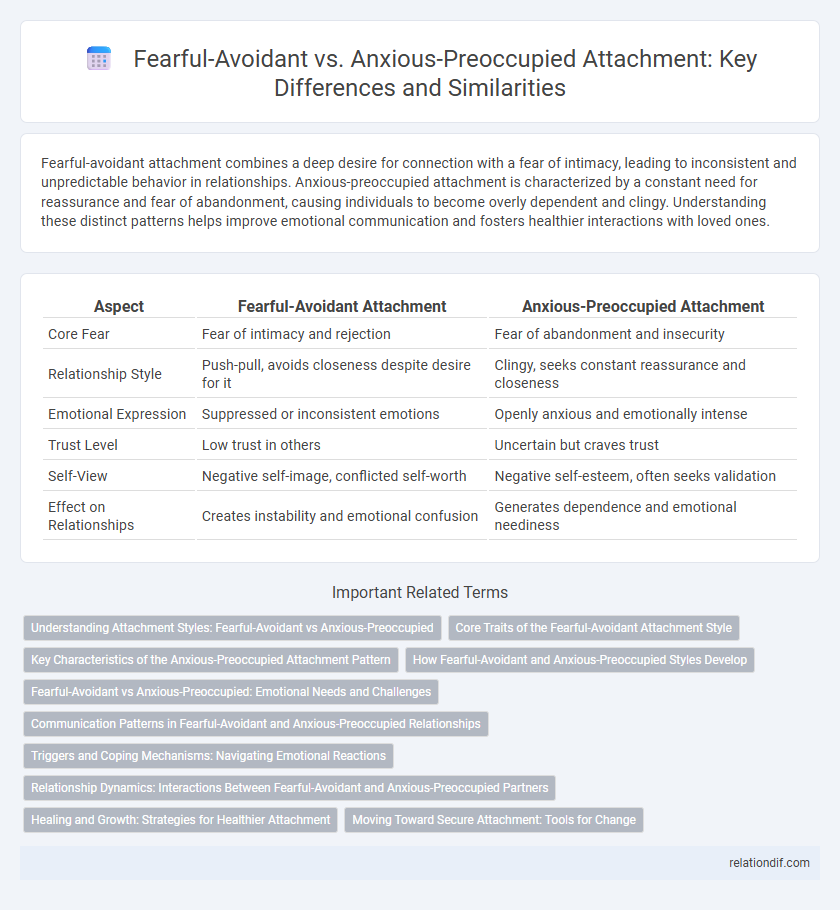Fearful-avoidant attachment combines a deep desire for connection with a fear of intimacy, leading to inconsistent and unpredictable behavior in relationships. Anxious-preoccupied attachment is characterized by a constant need for reassurance and fear of abandonment, causing individuals to become overly dependent and clingy. Understanding these distinct patterns helps improve emotional communication and fosters healthier interactions with loved ones.
Table of Comparison
| Aspect | Fearful-Avoidant Attachment | Anxious-Preoccupied Attachment |
|---|---|---|
| Core Fear | Fear of intimacy and rejection | Fear of abandonment and insecurity |
| Relationship Style | Push-pull, avoids closeness despite desire for it | Clingy, seeks constant reassurance and closeness |
| Emotional Expression | Suppressed or inconsistent emotions | Openly anxious and emotionally intense |
| Trust Level | Low trust in others | Uncertain but craves trust |
| Self-View | Negative self-image, conflicted self-worth | Negative self-esteem, often seeks validation |
| Effect on Relationships | Creates instability and emotional confusion | Generates dependence and emotional neediness |
Understanding Attachment Styles: Fearful-Avoidant vs Anxious-Preoccupied
Fearful-avoidant attachment is characterized by a deep fear of intimacy paired with a desire for closeness, often leading to mixed signals and emotional withdrawal in relationships. Anxious-preoccupied attachment features high dependency and fear of abandonment, resulting in clinginess and heightened sensitivity to rejection. Recognizing these patterns helps in addressing emotional needs and fostering healthier interpersonal dynamics.
Core Traits of the Fearful-Avoidant Attachment Style
The fearful-avoidant attachment style is characterized by a combination of high anxiety and high avoidance, leading to a deep fear of intimacy coupled with a desire for close relationships. Individuals often struggle with trust, experience intense emotional fluctuations, and exhibit conflicting behaviors such as approaching others while simultaneously pushing them away. Core traits include difficulty managing emotions, fear of rejection, and tendencies toward withdrawal under stress, distinguishing them from the anxious-preoccupied style which is marked primarily by anxiety and a need for reassurance.
Key Characteristics of the Anxious-Preoccupied Attachment Pattern
Anxious-preoccupied attachment is marked by intense emotional dependency and a strong desire for closeness coupled with fear of abandonment. Individuals with this pattern often exhibit hypervigilance to relational cues, leading to heightened anxiety and clinginess. This attachment style frequently results in difficulty trusting partners and a persistent need for reassurance in relationships.
How Fearful-Avoidant and Anxious-Preoccupied Styles Develop
Fearful-avoidant and anxious-preoccupied attachment styles develop through early childhood experiences characterized by inconsistent caregiving and emotional unavailability. Fearful-avoidant attachment often emerges from traumatic or neglectful environments where caregivers are both a source of fear and comfort, leading to ambivalence and mistrust. Anxious-preoccupied attachment typically arises from unpredictable responsiveness from caregivers, fostering anxiety and a heightened need for approval and closeness.
Fearful-Avoidant vs Anxious-Preoccupied: Emotional Needs and Challenges
Fearful-avoidant individuals struggle with deep-seated fears of rejection and intimacy, leading to unpredictable emotional withdrawal and vulnerability, while anxious-preoccupied individuals exhibit heightened neediness and fear of abandonment, driving persistent seeking of reassurance. Fearful-avoidant attachment is marked by conflicting desires for closeness and distance, causing instability in relationships, whereas anxious-preoccupied attachment features hyper-sensitivity to relationship dynamics and dependency. Meeting the emotional needs of fearful-avoidant individuals requires fostering safety and trust without pressure, while anxious-preoccupied individuals benefit from consistent validation and clear communication.
Communication Patterns in Fearful-Avoidant and Anxious-Preoccupied Relationships
Fearful-avoidant individuals often exhibit inconsistent communication, alternating between seeking closeness and withdrawing abruptly, creating confusion and emotional distance. Anxious-preoccupied partners tend to communicate with high emotional intensity and seek constant reassurance, which may overwhelm the fearful-avoidant's need for space. These opposing patterns frequently result in cycles of miscommunication, where fear of rejection clashes with the desire for intimacy, complicating relationship stability.
Triggers and Coping Mechanisms: Navigating Emotional Reactions
Fearful-avoidant attachment triggers often stem from fears of rejection coupled with a deep desire for closeness, leading to conflicting emotional responses that complicate relationship stability. Anxious-preoccupied individuals typically experience triggers related to perceived abandonment and inconsistency, which amplify emotional distress and dependency behaviors. Effective coping mechanisms for fearful-avoidant types include developing emotional awareness and setting healthy boundaries, while anxious-preoccupied individuals benefit from self-soothing techniques and fostering open communication to manage insecurities.
Relationship Dynamics: Interactions Between Fearful-Avoidant and Anxious-Preoccupied Partners
Fearful-avoidant partners often struggle with trust and intimacy, leading to push-pull dynamics that heighten anxious-preoccupied partners' need for reassurance and closeness. Anxious-preoccupied individuals may exhibit heightened emotional expressiveness, which can overwhelm fearful-avoidants, increasing withdrawal behaviors. This interaction cycle creates a feedback loop where the fearful-avoidant's distancing intensifies the anxious-preoccupied partner's anxiety, complicating relationship stability.
Healing and Growth: Strategies for Healthier Attachment
Healing fearful-avoidant attachment involves building trust through consistent emotional availability and practicing vulnerability in safe relationships. Anxious-preoccupied individuals benefit from developing self-soothing techniques and fostering secure boundaries to reduce dependency and anxiety. Both attachment styles require therapy modalities like cognitive-behavioral therapy (CBT) or emotionally focused therapy (EFT) to promote healthier attachment patterns and emotional regulation.
Moving Toward Secure Attachment: Tools for Change
Fearful-avoidant and anxious-preoccupied attachment styles often result in emotional turbulence that hinders secure bonding, but tools like consistent emotional validation, mindfulness practices, and cognitive-behavioral techniques can foster self-awareness and emotional regulation. Engaging in secure attachment behaviors such as open communication and vulnerability helps reframe relational patterns and promotes trust-building in intimate relationships. Therapy modalities like attachment-based therapy and emotion-focused therapy provide structured pathways for moving toward secure attachment by addressing deep-seated fears and reinforcing positive relational experiences.
fearful-avoidant vs anxious-preoccupied Infographic

 relationdif.com
relationdif.com